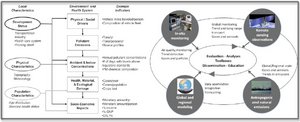PAPILA combines for the first time an ensemble of state-of-the-art models, high-resolution emission inventories, space observations and surface measurements to provide real time forecasts and analysis of regional air pollution in the LAC region. To reach this objective, the project will bring together aninterdisciplinary team of scientists from Europe, Latin America (Argentina, Bolivia, Brazil, Chile, Colombia, Mexico, Venezuela) and the Caribbean (Puerto Rico), and foster synergies between the groups involved in research and service activities. The project will co-develop with users and other stakeholders several products and services of importance for the LAC region. An important objective of the project is to make use of complementary competence to develop innovative ideas, to establish sustained partnerships between research groups, to transfer information to the public, to develop educational activities and to create a dialogue with interested stakeholders. Societal impacts, specifically on human health and on crop production will be assessed. Economic benefits of mitigation policies will be quantified. Finally, the planned activities will provide the basis for education and capacity building, and contribute to career development.
Scientific Objectives
The Air Quality Analysis and Forecast System (Figure below) that will be produced at the completion of the Papila Project will include:
(a) a real-time state-of-the-art multi-model quasi-operational air quality prediction system that will forecast the four dimensional distribution of air pollutants (reactive species and particulate matter) and provide related health indices,
(b) a real-time (quasi-operational) chemical data system that collects and processes observations of air pollutants;
(c) a state-of-the-art data assimilation system that will provide best estimates of the atmospheric chemical state via integration of Earth observations (specifically space observations) in chemistry transport model predictions;
(d) an emission inventory based on direct “bottom-up” estimates of anthropogenic sources and on “top-down” inverse modelling methodology (following the efforts undertaken by Andrade et al., 2016);
(e) dissemination platforms that will release daily “chemical weather” forecasts with quantified uncertainties, and
(f) exchanges and transfer of results to national and international agencies.


